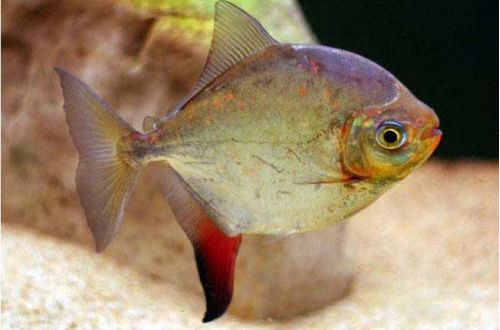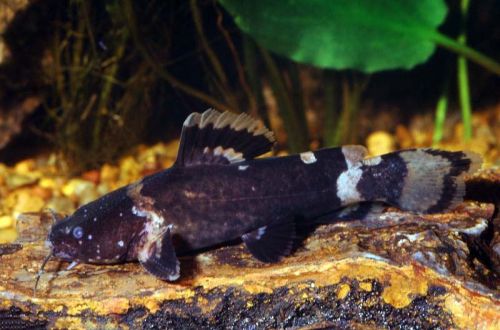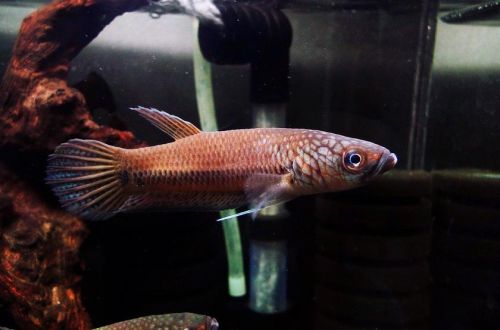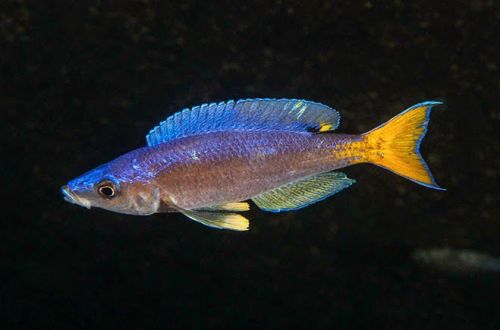
Mileus-luna
Mileus-moon or Mileus redfin, scientific name Myloplus rubripinnis, belongs to the family Serrasalmidae (Piranidae). A large schooling fish, peacefully tuned in relation to other inhabitants of an aquarium of a comparable size. However, smaller fish may be accidentally eaten. Keeping is relatively easy if a balanced plant-based diet and a large, spacious tank can be provided.

Contents
Habitat
Comes from South America. It occurs in almost all major river systems of the continent in the tropical climate zone. Inhabits areas of slow-flowing rivers near the coastline with dense aquatic and overhanging vegetation.
Brief information:
- The volume of the aquarium – from 300 liters.
- Temperature – 24-28°C
- Value pH — 6.0–7.0
- Water hardness – soft (up to 10 dH)
- Substrate type – any
- Lighting – subdued
- Brackish water – no
- Water movement – light or moderate
- The size of the fish is up to 25 cm.
- Nutrition – plant-based feed
- Temperament – peaceful
- Keeping in a group of 4-5 individuals
Description
The fish have a high disc-shaped body. Adult individuals reach a length of up to 25 cm. The color is predominantly monochromatic silvery. Males differ from females in a more elongated red anal fin.
Maintenance and care, arrangement of aquariums
A shoal of 4–5 fish will require a large aquarium of 260–300 liters, with the key being the length and width of the tank rather than its height (depth). Optimal conditions are achieved in soft, slightly acidic water rich in oxygen. The lighting is subdued.
The design must provide for open areas for swimming and places for shelters, for example, from a pile of natural snags. It is not recommended to use thickets of plants as an escape, since the Mileus-moon are herbivorous species.
Food
In nature, the basis of the diet is the leaves of plants, including surface (shrubs, trees), flooded during the rainy season. In the home aquarium, the diet should consist of plant-based foods. A number of manufacturers produce special foods for such fish in the form of dry flakes and granules. Sliced vegetables and soft fruits such as cucumbers, zucchini, green peas, fresh lettuce, spinach, etc. can be additional foods.
Although a plant-based diet is the main diet, protein supplements are also important, so it is advisable to use an all-purpose dry food, or occasionally feed live or frozen brine shrimp, bloodworms, and other small invertebrates.
In some cases, they can eat smaller aquarium neighbors.
Behavior and Compatibility
Being a flocking species, they need the company of relatives. A group of 4-5 individuals is recommended. Peacefully tuned to species of comparable size, while small fish will be at risk. Since Mileus redfin prefers the middle and upper layers of water, bottom dwellers from among the catfish, for example, Plecostomus and Bronyakovy, will become good neighbors.
Fish diseases
The main threat to the health of this species is an unbalanced diet. Poor nutrition depresses the immunity of the fish and it becomes susceptible to various diseases, the pathogens of which are low present in the environment. In case of illness, the first thing to pay attention to is the basis of the diet. Read more about the causes, diagnosis and treatment methods in the “Diseases of aquarium fish” section.





